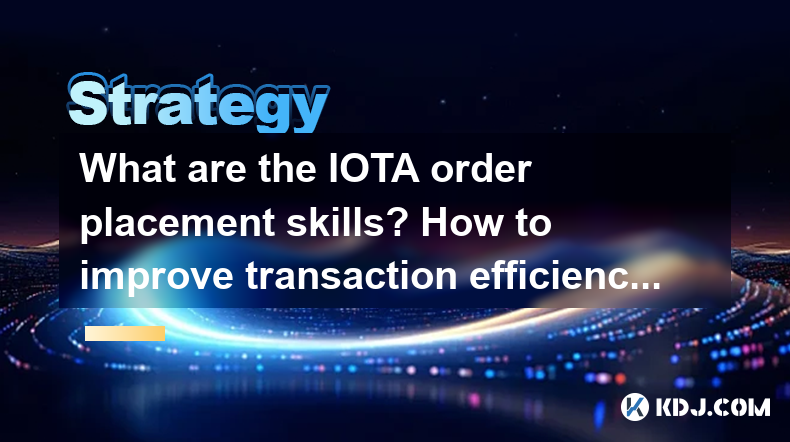-
 bitcoin
bitcoin $122659.385674 USD
0.52% -
 ethereum
ethereum $4484.113342 USD
-0.09% -
 bnb
bnb $1304.229256 USD
-0.85% -
 tether
tether $1.000204 USD
-0.03% -
 xrp
xrp $2.860636 USD
-0.51% -
 solana
solana $227.288799 USD
2.36% -
 usd-coin
usd-coin $0.999805 USD
0.01% -
 dogecoin
dogecoin $0.252837 USD
1.18% -
 tron
tron $0.341149 USD
1.12% -
 cardano
cardano $0.830507 USD
0.33% -
 hyperliquid
hyperliquid $45.792319 USD
0.04% -
 chainlink
chainlink $22.422164 USD
1.55% -
 ethena-usde
ethena-usde $1.000283 USD
0.01% -
 sui
sui $3.511389 USD
0.83% -
 stellar
stellar $0.385276 USD
-0.44%
What are the IOTA order placement skills? How to improve transaction efficiency?
IOTA uses the Tangle for feeless, scalable transactions; mastering order placement involves understanding the Tangle, optimizing PoW, and timing transactions effectively.
May 07, 2025 at 12:49 am

IOTA, known for its unique approach to distributed ledger technology, uses a Directed Acyclic Graph (DAG) called the Tangle instead of traditional blockchain. Understanding the skills required for order placement in IOTA and improving transaction efficiency involves delving into the specifics of the Tangle and the mechanics of the IOTA network. This article will explore these aspects in detail, providing you with the knowledge to enhance your IOTA trading experience.
Understanding IOTA's Tangle and Transaction Mechanics
The Tangle is the backbone of IOTA's network, where transactions are not grouped into blocks but are instead validated directly by other transactions. This structure allows for feeless transactions and theoretically infinite scalability. When you place an order in IOTA, you're essentially adding a transaction to the Tangle, which then needs to be validated by other transactions.
To place an order, you need to understand that each transaction in IOTA requires you to validate two other transactions. This process is known as Proof of Work (PoW), and it's crucial for maintaining the integrity of the network. The efficiency of your transaction depends on how quickly it gets validated by the network.
Skills for Effective Order Placement in IOTA
Placing an order in IOTA involves more than just initiating a transaction. Here are some key skills you need to master:
Understanding the Tangle's Dynamics: Since transactions in IOTA depend on other transactions for validation, understanding the current state of the Tangle can help you place orders more effectively. Tools like IOTA's own Tangle explorer can provide insights into the network's activity.
Optimizing Proof of Work: The PoW required for each transaction can be adjusted. By fine-tuning the PoW settings, you can balance the speed of transaction confirmation with the computational resources you're willing to use.
Timing Your Transactions: The Tangle's activity varies throughout the day. Placing your order when the network is more active can lead to faster validation and confirmation.
Using Reliable Nodes: IOTA's network is decentralized, and the node you connect to can affect your transaction's speed. Using a reliable and well-connected node can improve your transaction efficiency.
Steps to Place an Order in IOTA
Here are the detailed steps to place an order in IOTA:
Choose a Wallet: Start by selecting a wallet that supports IOTA. Popular options include Trinity Wallet and Firefly Wallet.
Fund Your Wallet: Ensure your wallet is funded with enough IOTA tokens to cover the transaction amount and any potential fees.
Configure Your Transaction: Open your wallet and navigate to the send/receive section. Enter the recipient's address and the amount you wish to send.
Adjust PoW Settings: Depending on your wallet, you might be able to adjust the PoW settings. Higher PoW can lead to faster confirmation but requires more computational power.
Initiate the Transaction: Once you've entered all the details, initiate the transaction. Your wallet will perform the necessary PoW to validate two other transactions on the Tangle.
Monitor the Transaction: Use a Tangle explorer to monitor the status of your transaction. It should show as pending until it's confirmed by the network.
Improving Transaction Efficiency in IOTA
Improving transaction efficiency in IOTA involves several strategies:
Optimize Your Node Connection: As mentioned earlier, connecting to a reliable node can significantly improve your transaction speed. Consider using a node with a high uptime and good connectivity.
Adjust PoW Settings: Experiment with different PoW settings to find the optimal balance between speed and resource usage. Some wallets allow you to adjust the minimum weight magnitude (MWM), which affects the PoW difficulty.
Batch Transactions: If you need to make multiple transactions, consider batching them into a single transaction. This can reduce the overall time spent waiting for confirmations.
Stay Informed About Network Conditions: Use tools like Tangle explorers to stay informed about the current state of the network. Avoid placing orders during times of high congestion.
Tools and Resources for IOTA Trading
To enhance your IOTA trading experience, consider using the following tools and resources:
Tangle Explorer: Websites like the official IOTA Tangle explorer or third-party explorers like TangleBay provide real-time data on the network's activity.
IOTA Wallets: Wallets like Trinity and Firefly offer user-friendly interfaces for managing your IOTA transactions. They also provide insights into your transaction's status and network conditions.
IOTA Forums and Communities: Engaging with the IOTA community can provide valuable insights and tips from experienced traders. Platforms like Reddit and the official IOTA forum are great places to start.
IOTA News and Updates: Staying updated with the latest developments in IOTA can help you make more informed trading decisions. Follow official IOTA social media channels and blogs for the latest news.
Practical Tips for IOTA Order Placement
Here are some practical tips to enhance your order placement skills in IOTA:
Test Small Transactions: Before placing large orders, test the network with small transactions to understand the current confirmation times.
Use Multiple Wallets: Having multiple wallets connected to different nodes can help you find the fastest route for your transactions.
Monitor Transaction Fees: Although IOTA transactions are generally feeless, some wallets might charge a small fee for certain operations. Keep an eye on these fees to optimize your costs.
Stay Updated on IOTA's Updates: IOTA's technology is constantly evolving. Staying updated on the latest updates and improvements can help you adapt your trading strategies accordingly.
Frequently Asked Questions
Q: How does IOTA's Tangle differ from traditional blockchains?A: IOTA's Tangle uses a Directed Acyclic Graph (DAG) instead of a traditional blockchain. In the Tangle, each transaction validates two other transactions, allowing for feeless transactions and theoretically infinite scalability. Traditional blockchains, on the other hand, group transactions into blocks and require miners to validate these blocks, which can lead to fees and scalability issues.
Q: Can IOTA transactions be reversed?A: No, IOTA transactions are irreversible once they are confirmed on the Tangle. This is similar to most cryptocurrencies, where transactions are final once they are included in the network.
Q: What happens if my IOTA transaction is stuck?A: If your IOTA transaction appears to be stuck, it might be due to low network activity or high congestion. You can try reattaching the transaction to different nodes or increasing the PoW settings to help it get confirmed. If the issue persists, consider reaching out to the IOTA community for assistance.
Q: Are there any risks associated with IOTA transactions?A: Yes, like any cryptocurrency, IOTA transactions carry certain risks. These include potential network congestion, security vulnerabilities in wallets, and the risk of losing access to your funds if you lose your private keys. It's essential to use secure wallets and follow best practices for managing your IOTA tokens.
Disclaimer:info@kdj.com
The information provided is not trading advice. kdj.com does not assume any responsibility for any investments made based on the information provided in this article. Cryptocurrencies are highly volatile and it is highly recommended that you invest with caution after thorough research!
If you believe that the content used on this website infringes your copyright, please contact us immediately (info@kdj.com) and we will delete it promptly.
- Whale Profit, Memecoins, and PEPE Volatility: A New Yorker's Take
- 2025-10-09 12:25:16
- BNB, MAGACOIN FINANCE, and ROI: Catching the Next Wave
- 2025-10-09 12:45:12
- BlockDAG, Formula 1, and Crypto Investing: A Winning Combination?
- 2025-10-09 12:25:16
- Shayne Coplan, Polymarket, and the POLY Token: Is Launch Imminent?
- 2025-10-09 12:30:03
- Trump Coin ETF, DTCC Listing, TRPC Ticker: A New Era for Political Meme Coins?
- 2025-10-09 11:40:03
- NYSE, Polymarket, and MAGACOIN: Wall Street Bets on Web3, Retail Traders Follow Suit
- 2025-10-09 11:40:03
Related knowledge

Practical parameter settings for a Bitcoin multi-timeframe moving average system
Sep 18,2025 at 10:54pm
Optimizing Timeframe Combinations for Bitcoin Trading1. Selecting appropriate timeframes is crucial when building a multi-timeframe moving average sys...

How can I filter out false breakouts in Dogecoin high-frequency trading?
Sep 22,2025 at 01:00am
Understanding False Breakouts in Dogecoin Trading1. A false breakout occurs when Dogecoin's price appears to move beyond a defined support or resistan...

Techniques for identifying tops and bottoms in the Bitcoin on-chain NVT model
Sep 20,2025 at 07:54pm
Understanding the NVT Model in Bitcoin Analysis1. The Network Value to Transactions (NVT) ratio is often described as the 'P/E ratio' of the cryptocur...

What does the surge in open interest in Bitcoincoin futures mean?
Sep 20,2025 at 11:18pm
Understanding the Surge in Dogecoin Futures Open Interest1. A surge in open interest within Dogecoin futures indicates a growing number of active cont...

How can I use the Ethereum USDT premium to gauge market sentiment?
Sep 18,2025 at 11:55pm
Understanding the Ethereum USDT Premium1. The Ethereum USDT premium refers to the price difference between USDT (Tether) traded on Ethereum-based plat...

What should I do if Ethereum staking yields decline?
Sep 20,2025 at 06:18am
Understanding the Causes Behind Declining Ethereum Staking Yields1. The Ethereum network transitioned to a proof-of-stake consensus mechanism with the...

Practical parameter settings for a Bitcoin multi-timeframe moving average system
Sep 18,2025 at 10:54pm
Optimizing Timeframe Combinations for Bitcoin Trading1. Selecting appropriate timeframes is crucial when building a multi-timeframe moving average sys...

How can I filter out false breakouts in Dogecoin high-frequency trading?
Sep 22,2025 at 01:00am
Understanding False Breakouts in Dogecoin Trading1. A false breakout occurs when Dogecoin's price appears to move beyond a defined support or resistan...

Techniques for identifying tops and bottoms in the Bitcoin on-chain NVT model
Sep 20,2025 at 07:54pm
Understanding the NVT Model in Bitcoin Analysis1. The Network Value to Transactions (NVT) ratio is often described as the 'P/E ratio' of the cryptocur...

What does the surge in open interest in Bitcoincoin futures mean?
Sep 20,2025 at 11:18pm
Understanding the Surge in Dogecoin Futures Open Interest1. A surge in open interest within Dogecoin futures indicates a growing number of active cont...

How can I use the Ethereum USDT premium to gauge market sentiment?
Sep 18,2025 at 11:55pm
Understanding the Ethereum USDT Premium1. The Ethereum USDT premium refers to the price difference between USDT (Tether) traded on Ethereum-based plat...

What should I do if Ethereum staking yields decline?
Sep 20,2025 at 06:18am
Understanding the Causes Behind Declining Ethereum Staking Yields1. The Ethereum network transitioned to a proof-of-stake consensus mechanism with the...
See all articles










































































